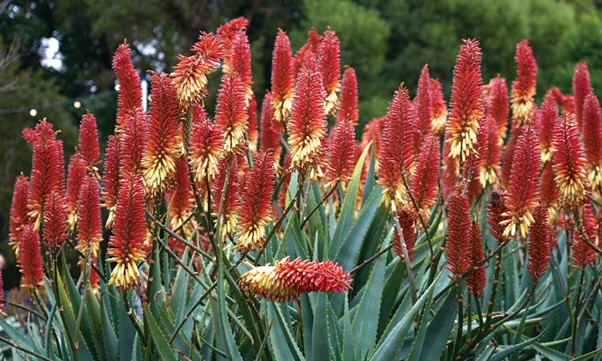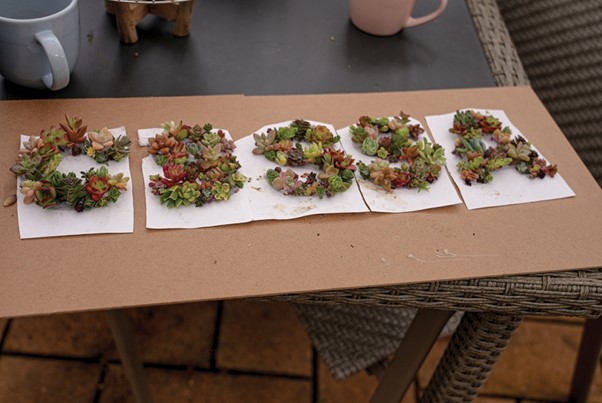
Welcome to the easy-care world of succulents, where you’ll be growing them one day and propagating them the next.
If there’s one group of plants that has enjoyed a renaissance – particularly among a younger generation of gardeners – it’s the succulent. The renewed interest in succulents has spawned a whole new appreciation for this incredibly robust and fascinating group of plants.
The millennium drought in the early 2000s, and its enforced water restrictions, also caused gardeners to reassess their irrigation regimens and plant choices. While it was a surprise to a lot of gardeners at how many plants survived and even thrived with a change in watering practice, it certainly brought succulents to the fore.
Renowned for their ability to withstand dry periods, more and more pockets of succulent varieties have slowly worked their way into prominent places in home gardens.
Originating from the arid and semi-arid regions of Africa, succulents adapted to these harsh conditions through the evolution of water-retaining leaves and stems. The plants’ abilities to capture and store moisture has put them in good stead to play a prominent role in a climate-changing garden.
Another upside to the focus on succulents has been the explosion of “plant hunters” looking for rare and unusual varieties. Beyond the widely grown species of echeveria, aeonium, jade and sedums, there’s a whole world of on-trend succulents. With thousands of varieties displaying differing growth habits, shapes, colours, and textures, it’s enough to keep anyone interested.
One group of people viewing the changing and positive attitude to these plants is the Cactus and Succulent Society of South Australia (CASSSA).
Formed in 1964, CASSSA has, over the years, dedicated itself to the promotion, understanding, cultivation and conservation of cacti and succulents to growers in South Australia. Opening doors to all – and currently boasting a healthy membership – a casual drop-in to one of their monthly meetings is the perfect way to learn more.
For Janelle Zara, her CASSSA membership, purchased more than five years ago, has been the springboard into developing a deep connection and business opportunity with succulents. The former hair stylist, whose introduction to succulents was sparked by the receipt of a “living” gift, has now immersed herself, as well as her front and back gardens, in the pursuit of establishing an impressive and increasing succulent range.

Tiered benches and mesh tables are filled with all manner of pots and plants and are testament to Janelle’s passion and propagating prowess. She’s quick to point out that this knowledge was passed to her willingly by CASSSA members (as they readily give to all), with her every question answered. Ask about what drives Janelle and the other members in their succulent pursuits, she says it’s the ability to “create”, because few other plants can be divided and multiplied in the same way as succulents. Even raising new varieties from seed is possible, which adds another creative dimension.
Unlike other plants, cuttings taken from succulents are not time sensitive; far from it. Whether a trimmed leaf or stem, the removed section is laid on an airing rack to dry and create a callous around the cut. Taking anywhere from a few days to a week, it is from these healed edges that new roots form.
Stem cuttings are best taken from plants, such as Aeonium, where it is easy to access with a pair of secateurs. Snip a long piece, making sure there is a tuft of growth at the top. Push in callused stems into a pot or the ground.
For clumping varieties, such as Echeveria, that have tight heads which make it difficult to cut with snips, use a piece of fishing line: feed and loop the line into the head, cross over and tighten. The fishing line slices through the centre, severing the top and making it easy to pick out leaves or replant the clump. A sharp knife or scalpel is ideal at trimming off leaves in more open-headed succulents.
Next, lay leaves on a potting-mix-filled tray, pushing the cut end in slightly. Give a mist now and again and watch as the magic of a new plant is borne from the base. This mimics how leaves, which naturally fall to the ground, set root.
Some plants like Agave, produce new plants at their base along the stem. These “pups” can be cut off with a sharp knife. Simply treat them like a stem cutting and plant out after a week.
When cutting for propagation, it’s best to leave some foliage on the mother plant. The remaining foliage provides food and energy for that plant to recover and re-establish itself more quickly.
While succulents are sun lovers, they do enjoy some shading from the late afternoon sun to avoid scorching stems and leaves. When planting in home gardens, aesthetics and ornamental elements are an important consideration, so the better a plant looks, the better its garden appeal.
Drainage is also very important. Having evolved to survive in low rainfall areas, their root system can’t cope with overly moist soils, resulting in plants rotting and dying. Free-draining ground or potting mix is essential.
Often overlooked, but nevertheless a major feature, is the succulents’ blooms. Stare into the bright yellow flower head of an Aeonium and you’ll be amazed at the complex array of tiny daisy flowers, perfectly arranged.
Conophytums, sometimes called “Living Pebbles”, are strange-looking dwarf succulents that form dense clusters of fused leaves. Divided into day, twilight, or night blooming varieties, their small daisy like flowers come in a range of colours with orange or yellow centres.
Succulents benefit from an occasional handful of organic fertiliser like Dynamic Lifter or Rapid Raiser, or specialised cacti and succulent feeds when they are actively growing. Spread around the base and not on the leaves, making sure to avoid high nitrogen liquid feeds.
Frost is the natural enemy of succulents. They are moisture-filled, so a quick drop in temperature can freeze, split, and damage the plant cells resulting in severe injury to leaves and stems, which results in a mushy mess once they’ve thawed.
Janelle is always looking for creative and artistic ways to use succulents beyond their pots: she makes her own cards, decorating with an assortment of succulents, which turns them into living gifts, that once received and read, can be planted to start a new succulent garden. It’s always best to check with interstate biosecurity regulations before posting outside of SA.
This article first appeared in the Summer 2022 issue of SALIFE Gardens and outdoor living magazine.
Words: Kim Syrus


